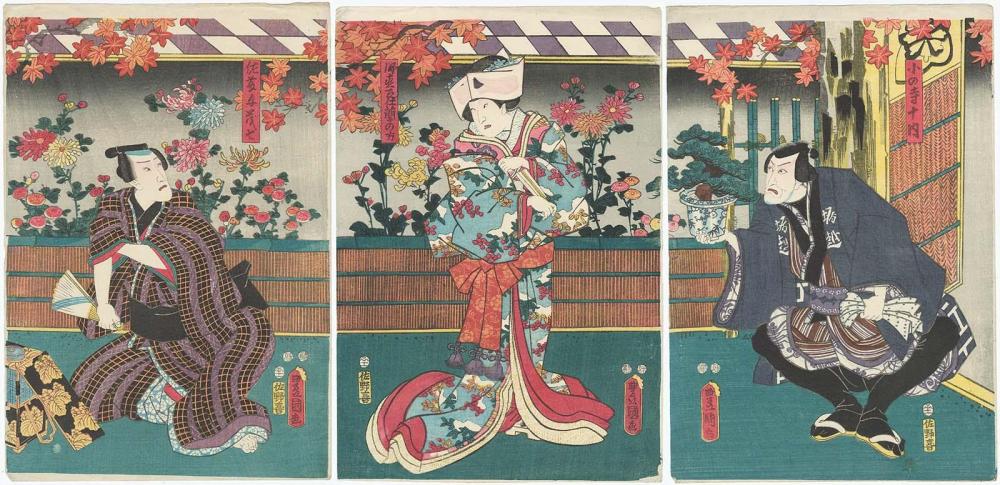Advanced Search 
「小の寺十内」 五代目市川海老蔵 「師直召仕蘭の方」 三代目嵐璃寛 「佐藤与茂七」 八代目市川団十郎

Actors Ichikawa Ebizô V as Onodera Jûnai (R), Arashi Rikan III as Moronao's Attendant Lady Ran (Moronao meshitsukai Ran no kata) (C), and Ichikawa Danjûrô VIII as Satô Yomoshichi (L)
「小の寺十内」 五代目市川海老蔵 「師直召仕蘭の方」 三代目嵐璃寛 「佐藤与茂七」 八代目市川団十郎
Utagawa Kunisada I (Toyokuni III) (Japanese, 1786–1864)
Publisher: Sanoya Kihei (Kikakudô) (Japanese)
Publisher: Sanoya Kihei (Kikakudô) (Japanese)
Japanese
Edo period
1852 (Kaei 5), 11th month
Medium/Technique
Woodblock print (nishiki-e); ink and color on paper
Dimensions
Vertical ôban triptych; 37.8 x 77.3 cm (14 7/8 x 30 7/16 in.)
Credit Line
William Sturgis Bigelow Collection
Accession Number11.43962a-c
NOT ON VIEW
CollectionsAsia, Prints and Drawings
ClassificationsPrints
Flower shows featuring spectacular chrysanthemum exhibits were such a well-known feature of autumn in Edo that they could even serve as colorful backgrounds for scenes in Kabuki plays. In this spinoff from The Storehouse of Loyal Retainers (Chūshingura), the most popular of all Kabuki plays, two of the forty-seven loyal samurai seeking vengeance for their late master pose as florists to spy on the villain and his household, chatting with a lady-in-waiting at the mansion they will eventually break into.
DescriptionPlay: Chûkô Kanagaki Kôshaku
Theater: Kawarazaki
忠孝仮名書講釈(ちゅうこうかながきこうしゃく)
河原崎座
1852(嘉永05)11・12
Theater: Kawarazaki
忠孝仮名書講釈(ちゅうこうかながきこうしゃく)
河原崎座
1852(嘉永05)11・12
Signed
Toyokuni ga, in toshidama cartouche (on each sheet)
豊国画(年玉枠)
豊国画(年玉枠)
Marks
Censors' seals: Mera, Watanabe, Rat 11
No blockcutter's mark
改印:米良、渡辺、子十一
彫師:なし
No blockcutter's mark
改印:米良、渡辺、子十一
彫師:なし
ProvenanceBy 1911, purchased by William Sturgis Bigelow (b. 1850–d. 1926), Boston [see note 1]; 1911, gift of Bigelow to the MFA. (Accession Date: January 19, 2005)
NOTES:
[1] Much of Bigelow's collection of Asian art was formed during his residence in Japan between 1882 and 1889, although he also made acquisitions in Europe and the United States. Bigelow deposited many of these objects at the MFA in 1890 before donating them to the Museum's collection at later dates.
NOTES:
[1] Much of Bigelow's collection of Asian art was formed during his residence in Japan between 1882 and 1889, although he also made acquisitions in Europe and the United States. Bigelow deposited many of these objects at the MFA in 1890 before donating them to the Museum's collection at later dates.
